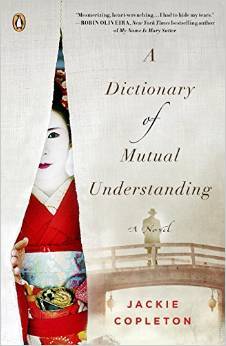Thank you to Viking / Penguin Books for sending this absolutely wonderful debut novel! I needed tissues at the end of this beautiful book. I’ll say that right up front to let you know this is a very emotional read that packs plenty of power and beauty inside its pages.
“In the tradition of Memoirs of a Geisha and The Piano Teacher, a heart-wrenching debut novel of family, forgiveness, and the exquisite pain of love.”
And while I have not read The Piano Teacher, I have read Memoirs of a Geisha. And can agree that there are parts in here that give the feel of Memoirs and that only made it just that extra bit special. There is so much in here, the writing is beautiful, it’s exquisite really, and the layers, the emotions, the journey. The power and the emotions, inside – it really is an exquisite debut.
I did not write down all the beautifully written sentences contained inside, I’m sure if I did, I would have been transcribing the whole novel, but this sentence I did write down to share:
“We had so few hours left to glue dead leaves to an infected family tree.”
(at the 87% mark of the book) (This is Amaterasu thinking this in the present time when she is with Hideo.)
And this one as well: “Together we put you in the path of pikadon.” about Yuko, and said by Sato and Yuko’s mother keeping them apart.
I know it is hard to truly feel the impact of those two brief sentences, put down here, but I can tell you that when I read them in the context of the story, the power of them washed right over me and I was left in a moment of awe. There are many moments in this book where you pause, re-read and think on the feeling, beauty and emotion of what you’ve just read.
Amaterasu is now living in the US, her husband has recently passed away and she continues to live with the shame and guilt of leaving behind Nagasaki. They fled Nagasaki following the bombing (called Pikadon), wishing to leave behind the pain and sorrow of losing their only daughter, Yuko and her son, Hideo. On the day of the bombing, Amaterasu had just dropped her beloved grandson off at school and was to meet her daughter at the cathedral to discuss some serious and grave concerns. These concerns are not revealed to the reader, only that Amaterasu is deeply saddened by it and is something that has driven her and her daughter apart. But, before she heads down to the cathedral, she returns briefly home first. Their family home is higher above the valley and in those short moments, the entire world changes for Amaterasu. The bomb has decimated the cathedral and the school where Hideo attends is on fire and is reduced to rubble. There is very little hope that Hideo has survived, and almost no hope ever that Yuko has survived.
Here, Copleton’s descriptions of the aftermath of the Nagasaki bombing are breathtaking. Honestly taking your breath away – reading of the sounds, the smells, the sights, such as the skin falling off, melting away, peeling away from the bodies of those running, desperate to find safety. Incredible.
Unable to live with the guilt of surviving this horror without their daughter and grandson, the Takahashi’s move to America – a place as far away from Japan as they can imagine. Amaterasu brings with her Yuko’s journals and drawings and puts them far into hiding at the back of her closet. She has never read them, cannot bring herself to read her daughter’s thoughts. It is not until one day, almost 40 years following the bombing, that a horribly disfigured man appears on her doorstep claiming to be her grandson Hideo, does she reach deep into the depths of the closet to bring her daughters journals forward.
Hideo also brings with him as a way of showing proof of his identity, a box of letters that contain so many of the secrets Ama was determined to leave hidden behind in Japan. Here, the story will move back and forward in time, to reveal the life Ama had before she married, to the reason why she was so determined to drive her daughter apart from a man Ama refused to believe she should love. The letters will also reveal the reason why she asked that her daughter meet her in the cathedral on that terrible and ill-fated day.
There are so many layers to peel back here, from Ama’s past life, to her daughter’s journals, to the letters written by Sato, a man that Ama despises with such force, she cannot ever believe her beautiful daughter Yuko and Sato could ever share true love. Hideo continues to visit Ama as she continues to turn herself over to the past. He continues to hold out hope that Ama will trust him and know that he is truly her grandson. Ama struggles with this for she is still struggling with the guilt of the past and for surviving in Nagasaki.
In the end, Ama returns with Hideo to Nagasaki. “I had needed those four decades to find the strength to revisit the ghosts and the places where they hid.” (89% mark of the book) The ending requires many tissues. It is not so much the reveal of the past, that isn’t the part that is difficult to piece together, but instead it is the absolute beauty of this journey towards forgiveness and peace that will profoundly move you.
“This impressively layered first novel never strains credulity as it explores grief and guilt amid revelations of long-buried familial secrets, destructive love affairs, and more.” New York Times
The New York Times is championing A Dictionary of Mutual Understanding, and so is this Literary Hoarder. 4.5 stars for this stunning debut.
This was one of the books planned to be read for our book club for the month of January, and we may have to revisit this, because they have published a fantastic book club kit, complete with recipes to use! You can find that Book Club Kit here. It also features a Spotify playlist, Japanese recipes and discussion points.


